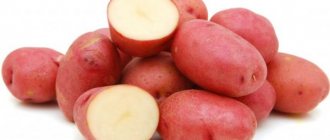When growing potatoes in areas where unstable weather conditions are observed, it is worth considering that the choice of planting material must be taken as responsibly as possible. If we take into account the description of the Typhoon potato variety, photos and reviews, we can safely say that the crop of this variety is excellent for growing in regions with variable climates. As a rule, it is recommended to grow the crop in Russia, Ukraine and Moldova.
Description of the potato variety Typhoon
The Typhoon variety was developed by breeders from Poland. For the first time, many gardeners paid attention to this variety in 2008, when the root crop was included in the State Register.
If we consider the description of Typhoon potatoes, we can highlight the following points:
- the tubers have an oval or round shape, slightly narrowed at the base;
- the peel is smooth, yellow;
- the pulp is quite juicy, the consistency is dense, yellow or cream in color when cut;
- starch content level is 16-20%;
- From each bush you can collect from 6 to 10 root vegetables.
As the bushes grow, they reach a large size; the tops stand straight. It is worth noting that the plants are quite powerful, with a large number of rich green leaves. During the flowering process, large white flowers appear.
Mid-early varieties.
Mid-early potato varieties
are represented mainly by the varieties “Visa”, “Odyssey” and “Gourmet”.
- "Visa" - grown in the central and black soil regions. The yield is average and can be stored for quite a long time. "Visa" is distinguished by an oval tuber, smooth red skin and light yellow fruit pulp.
- "Odyssey" - grown in the central and black soil regions. "Odyssey" can be recognized by its rounded root, yellow skin and yellow flesh.
- "Gourmet" is a dietary potato variety. It is distinguished by its dark purple skin and unusual blue-violet flesh.
Pros and cons of the variety
Plants of the Typhoon variety, like most other species, have a number of advantages and disadvantages. If we consider the strengths of potatoes, it is worth highlighting the following points:
- the crop is characterized by a high level of resistance to heat and dry weather;
- in the event that the bushes have been damaged by frost or hail, a fairly rapid recovery occurs, while this does not affect the yield and taste;
- Tubers of the Typhoon variety do not crack during growth and ripening and are not prone to hollowness or sprouting;
- the shelf life level is quite high and amounts to 95%;
- excellent taste of root vegetables;
- high level of resistance to many types of diseases and pests;
- low susceptibility to mechanical damage.
It is worth noting that this variety does not have any significant disadvantages.
Important! A distinctive feature is the fact that the crop is able to extract the moisture necessary for growth from the deep layers of the soil.
Landing rules
It is recommended to purchase seed material only from trusted suppliers. The main one, which provides customers with tubers measuring 30-60 mm in diameter, packaged.
Recommended timing
When planting potatoes, regional climate characteristics should be taken into account. Getting an early harvest is possible if you place seed material in the soil in April, if the soil has warmed up to 10-11 ° C. You first need to germinate the tubers. Planting is acceptable in May.
Soil preparation
The site should be sunny, with fertile soil. A good harvest can be obtained if carrots or cabbage, legumes, and melons were cultivated in the garden the previous year.
The area chosen for planting should be plowed together with humus in the autumn months. Fertilizer 5-7 kg per 1 m2 is placed over the site, 30 g of superphosphate is added to it.
If autumn work was not carried out, then humus can be added to the soil before spring digging. When planting Vzryvny potatoes in areas with a harsh climate, it is preferable to form high ridges where the tubers will be placed.
Important! To increase productivity, 100 g of wood ash should be poured into each hole.
How to plant correctly
Purchased tubers must be large, uniform in color, without signs of rot, fungal infection, or mechanical damage.
Planting Explosive potatoes can be done in several ways; it is important to provide the plant with sufficient lighting. To do this, place the tubers in the holes from south to north, maintaining an interval between holes of 20 cm
The row spacing must be at least 0.5 m.
Planting depth varies depending on the type of soil:
- in sandy soil 10-15 cm;
- in clayey 4-5 cm;
- in peat 8-10 cm.
A common planting method is smooth. Holes are dug in the soil, ash and humus are added to them, and tubers are placed on top. The distance between the holes is 50 cm. The tubers are sprinkled with earth and then watered.
Important! The ridge planting method is not recommended for clay soil. It weakly protects the tubers from adverse weather conditions. It is possible to grow Explosive potatoes in ridges
The method is relevant in regions with variable climates. In countries with hot summers, planting in ridges is not recommended: overheating of the root system is possible
You can grow Explosive potatoes in ridges. The method is relevant in regions with variable climates. In countries with hot summers, planting in ridges is not recommended: overheating of the root system is possible.
The beds are marked while maintaining a distance of 0.7 m between the rows. In dry weather, ridges 15 cm high are formed according to the markings. The tubers are laid out side by side, sprinkled with soil and spilled with water.
When the sprouts reach a height of 20 cm, the Explosive potatoes need to be hilled up, raising the soil between the rows onto a ridge. The procedure must be repeated 3 times per season, forming a ridge up to 0.5 m high.
This method allows you to grow crops in clay plots and vegetable gardens with close contact with groundwater.
Planting and caring for Typhoon potatoes
As practice shows, to obtain a high level of yield, Typhoon potatoes should be properly cared for. Among the main measures for caring for plants are:
- timely hilling of potatoes, especially at a time when active growth of tops is observed;
- weeds must be removed immediately as soon as they appear;
- loosening the soil;
- if there is a drought, it is necessary to establish a crop irrigation system;
- Throughout the season, it is necessary to apply fertilizer 2 times, especially if the root crops grow on poor soils.
To prevent weed growth, it is recommended to mulch the soil.
Selection and preparation of a landing site
As you know, to obtain a high level of harvest, it is necessary to first select and prepare a plot of land. Judging by the characteristics and reviews, Typhoon potatoes can be grown on any soil.
Before planting the crop in open ground, it is recommended to dig up the selected plot of land and carefully remove the weeds along with the root system. If the soil is infertile, it is worth adding fertilizers.
Preparation of planting material
Preliminary preparation of planting material can significantly increase the level of productivity. To process root crops, you can use the following means:
- growth stimulator - the composition includes microelements, thanks to which the process of awakening the eyes is accelerated;
- drugs that prevent the occurrence of diseases - in this case, you can use a solution of copper sulfate, into which the tubers are dipped for 2-3 minutes;
- means that protect tubers from pests.
If necessary, planting material can be germinated.
Landing rules
When carrying out planting work, you should adhere to the following rules:
- for growing Typhoon potatoes, it is recommended to choose black soil, sandy, loamy or peat soils;
- Potatoes can be planted in open ground at a time when the average daily air temperature outside is +15°C. As a rule, potatoes are planted in soil heated to +7°C to a depth of 12 cm;
- planting work is carried out from April to May. The early planting process allows harvesting in mid-summer. Young potatoes are eaten, and for storage they use earlier root crops that were planted back in May;
- There should be a distance of up to 35 cm between bushes, and the width between rows should not be less than 65 cm.
To obtain a high yield, it is recommended to plant Typhoon potatoes in areas where flax or lupins previously grew.
Advice! It is not recommended to plant Typhoon potatoes in one area for several years in a row, as the amount of harvest will be significantly reduced.
Watering and fertilizing
If you follow all agrotechnical rules in the process of growing typhoon potatoes, then it is worth considering that the crop must be irrigated once a week. As a result of the fact that potatoes are usually planted in large areas, they are watered once every 1-2 months. During the season it is worth applying fertilizers at least 2 times, which will allow you to get a high yield.
Loosening and weeding
Weeding Typhoon potatoes is important. Emerging weeds interfere with the growth and development of tubers, as weeds take all nutrients and moisture from the soil. As a rule, removing weeds and loosening the soil is done simultaneously with hilling the potatoes. It is recommended to remove weeds 3-4 times throughout the season.
Hilling
With the help of hilling, you can retain moisture, get rid of weeds and protect the crop from possible frosts. In addition, it is important to understand that this procedure helps to increase productivity, as air circulation improves in the places where the tubers are poured. Potatoes are hilled every time after rainfall or watering.
Landing
For planting, tubers must be specially selected and germinated. The size of seed potatoes is 4-7 cm, weight is 40-80 g. Larger material is cut, and the sections are sprinkled with ash powder. There should be 3-5 sprouts on each piece. Germination lasts 18-25 days.
Preparation comes down to disinfection, solutions for soaking:
- 40% formaldehyde;
- 1% Fitosporin;
- Acrobat;
- Gamair;
- 1% potassium permanganate.
To stimulate growth, farmers are advised to use Krezacin, Poteytin, Epin.
The planting time in the southern regions is from the 2-3rd decade of April; in the temperate zone, potatoes are planted in the first days of May. A prerequisite is the heating of the earth; the temperature should not fall below 8 degrees.
Potatoes are planted in different ways. In warm, dry areas, the trench or furrow method is suitable. To do this, dig trenches to a depth of 15 cm, cover with a thin layer of plant waste, and lay out the tubers with the sprouts facing up. Sprinkle with loose soil. The step between rows is 60 cm.
When groundwater is close, it is preferable to grow potatoes in ridges. The height of the embankment is 15-20 cm. But more often, farmers use the classic option - they plant potatoes in single or double rows.
Harvesting and storage
Since Typhoon potatoes are early ripening, harvesting can begin 65-75 days after planting the planting material in open ground.
It is worth noting that the harvesting principle is no different from other potato varieties. A few weeks before harvesting begins, it is recommended to mow the thick tops. It is recommended to harvest potatoes in sunny weather.
Since potatoes have a high level of shelf life, almost the entire crop can be sent for storage. The only thing that is required is to dry the potatoes in the sun, immediately remove the damaged fruits (some of them can be eaten), and select the seed material (it should be stored separately).
Attention! A cellar is used for storage. If Typhoon potatoes are not planted on a production scale, then bags of root crops can be stored on the balcony.
Pests and diseases
If all agrotechnical rules are observed, Typhoon potatoes will be maximally protected from diseases.
After all, it has strong immunity to viral infections (Y, L and M), golden nematode, scab, and late blight. But among pests, gardeners should be wary of the Colorado potato beetle. The plant is not resistant to these insects.
Without taking measures to combat the Colorado potato beetle, insects can cause enormous damage to the crop in a short time
When a pest appears, several control methods are used:
- manual collection;
- use folk remedies, for example, spraying with infusions of celandine, tansy or basil;
- In case of mass damage, broad-spectrum insecticides are used.
Mid-season varieties.
Among the mid-season potato varieties, “Kolobok”, “Pirol” and “Hozyayushka” stand out.
- “Kolobok” - as is easy to understand from the name, has a round tuber. It is distinguished by its yellow peel and softness, and can be stored for quite a long time.
- "Pirol" - grown in the Central regions. Oval tuber, yellow flesh and skin. Pyrol can be stored for a very long time.
- “Hostess” is a potato variety often used for making French fries, chips, and for baking. Recognizable by its red skin and light yellow flesh.
When you choose potato varieties, reviews
experienced summer residents and gardeners are very important. And yet, do not forget that first of all you need to remember the capabilities of your own site. Make your decision based on what you can actually grow—and what you'll need your potato crop for.











